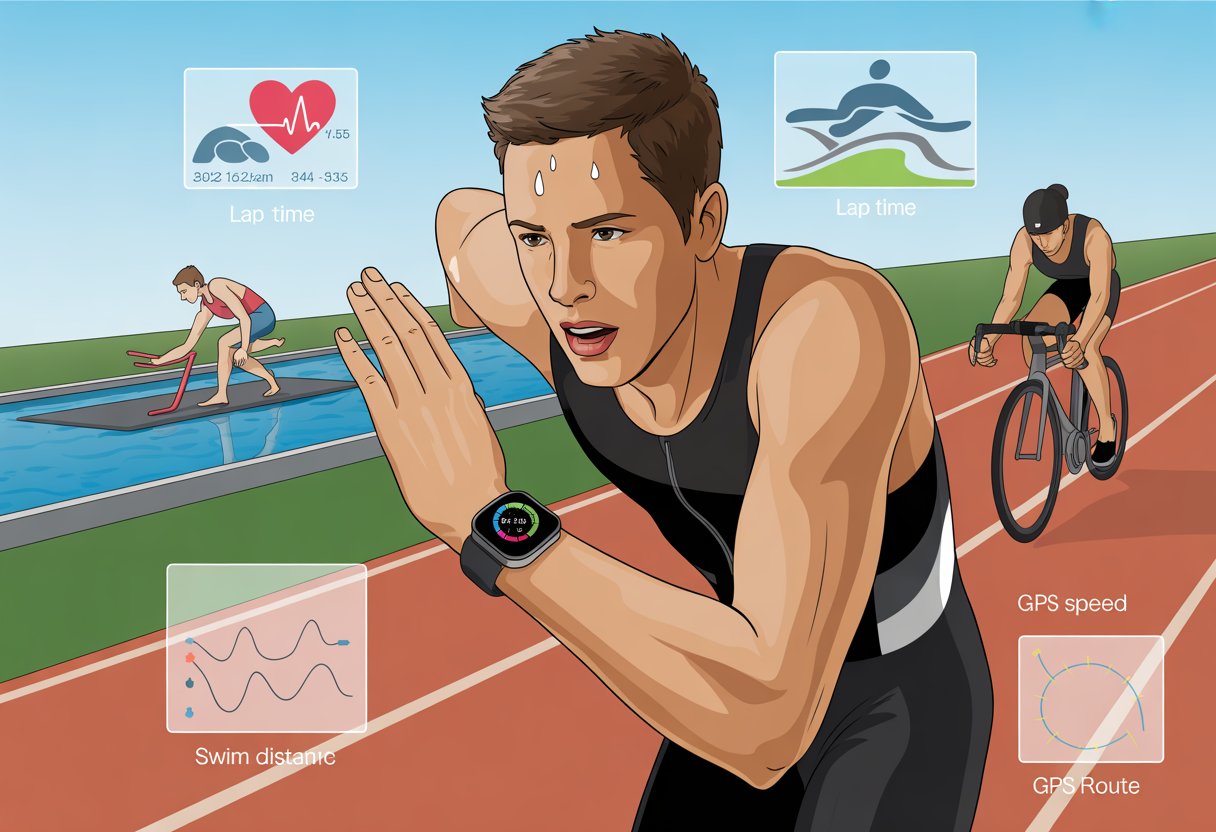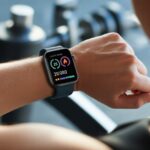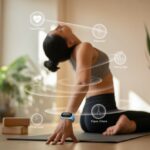Is it just us, or do we all wish we had a coach in our pocket—or at least on our wrist—while training for a triathlon? Our smartwatches might not bark at us to run faster, but they sure make triathlon prep a whole lot easier.
If we set them up right, smartwatches track our swims, bike rides, and runs in a single workout. That way, we only need to remember which shoes go with which sport, not every little detail.

Let’s be real—remembering if we started the timer during the chaos of T1 is hard. Features like multisport mode and automatic transition tracking let us focus on not putting our helmet on backward instead of fussing with buttons and losing precious seconds.
If we haven’t played with these, some watches, like Garmin models, have special triathlon features built just for training and race day.
Most of us want to train smarter, and these wrist gadgets help us log every stroke, spin, and step—no spreadsheets needed. Whether we’re prepping for our first sprint or eyeing a full Ironman, our smartwatch can be the silent teammate we never knew we needed.
Choosing the Right Smartwatch for Triathlon Training
Picking a smartwatch for triathlon isn’t as simple as grabbing the shiniest gadget off the shelf. We need tools that can keep up with our training, handle our sweat, and actually make our workouts smoother—not more complicated.
This means we have to look past the flashy ads and check for features made for swim-bike-run warriors like us.
Key Features to Look For
Not every smartwatch is made for triathlon battles. We want real multi-sport modes so the watch can shift from swimming, to cycling, to running with a tap—not with three angry pokes and a prayer.
Built-in GPS is a must unless we enjoy guessing how far we’ve actually run. And honestly, accuracy matters.
Water resistance isn’t just a party trick. A triathlon watch should handle open water swimming, not freak out when splashed at the sink.
Long battery life is non-negotiable. No one wants their watch to take a nap during the run leg.
Heart rate monitoring (ideally both wrist and chest compatibility) and a clear, readable screen are crucial. Nobody wants to squint at a blurry display after a two-hour ride.
Here’s a quick cheat sheet of must-have features:
| Feature | Why We Need It |
|---|---|
| Multi-sport modes | Easily track each discipline |
| Built-in GPS | Don’t get lost (again) |
| Water resistance | Survive every swim |
| Battery life | Lasts longer than our willpower |
| Heart rate monitor | Track effort, avoid collapse |
| Good screen | See stats mid-sprint |
Popular Brands and Models
We don’t need a tech degree to spot the big names in triathlon smartwatches. Garmin is basically the gold standard for multi-sport watches.
The Garmin Fenix series has built a reputation for accuracy and toughness. The Forerunner and Venu models also work well for both newbies and seasoned athletes.
Apple Watch Ultra is a crowd-pleaser, mostly for its bright display and health features. It’s more of a general fitness smartwatch than a hardcore triathlon beast, but it still handles the distance (and the swim, and the bike).
Polar brings strong options like the Polar Grit and Polar Vantage. Suunto smartwatches are rugged, with reliable tracking and great battery life.
Fitbit and Samsung watches are fine for everyday training, but sometimes miss features specific to race day chaos. Still, they’re user-friendly and cover enough ground for training or shorter races.
Comparing Multi-Sport Watches
Let’s admit it—everyone wants the “best” watch, but our wallets have feelings too. Garmin Fenix is pricey but packs the most advanced triathlon features and will probably outlast our running shoes.
The Venu and Forerunner lines land at a friendlier price for everyday athletes without dropping the crucial swim-bike-run stuff.
Apple Watch Ultra looks sharp and plays nice with other Apple gear, but its battery life might have us hunting for a charger mid-race. Polar Grit and Vantage are perfect for those who want ultra-precise workout data, plus they’re tough and last a while.
Suunto stands out with excellent GPS and simple controls—great for those of us who don’t want to spend an hour reading a manual.
Here’s how the big names stack up:
| Model | Price $ | Multi-Sport | Water Resistance | Battery Life | GPS Accuracy |
|---|---|---|---|---|---|
| Garmin Fenix | $$$ | Yes | Excellent | 40+ hr | High |
| Apple Watch Ultra | $$ | Good | Good | 12-36 hr | High |
| Polar Grit/Vantage | $$ | Yes | Great | 30-40 hr | High |
| Suunto Smartwatch | $$ | Yes | Excellent | 25-120 hr | High |
We just need to find what fits our goals, budget, and, honestly, our wrist size. Good luck out there!
Setting Up Your Smartwatch for Triathlon
When we gear up for a triathlon, setting up our smartwatch can make us feel like tech-savvy superheroes. With the right setup, we breeze through transitions, track our stats, and maybe even show off a little to our training buddies.
Configuring Sports Profiles
First, let’s squeeze every feature our watch offers by creating unique sports profiles for each triathlon leg: swim, bike, and run.
Most smartwatches (looking at you, Garmin) let us set up custom profiles, picking sport-specific data screens and alerts.
For swimming, we can add lap counting, distance, and pace to the display. On the bike, we want power output, speed, and heart rate front and center.
Running profiles should highlight pace, distance, and heart rate—unless we enjoy surprises mid-sprint.
We need to practice switching between profiles, so we don’t stand there in transition looking like we’re texting our mom. Many watches have a multisport mode, letting us go from one sport to the next with just a single button press.
Our goal is to keep fidgeting to a minimum and focus on not tripping over our own feet.
Integrating External Sensors
To squeeze out every bit of data—because let’s be honest, stats are half the fun—we should pair up our external sensors.
Most triathletes use ANT+ or Bluetooth heart rate monitors, power meters, and bike cadence sensors.
Pairing is usually straightforward. We jump into the settings, choose sensors, and let the watch do its digital handshake.
If we get stuck, a quick sensor reset or, who knows, standing on one leg (kidding) can help.
Before race day, we should check all sensors are connected and updating in real time. Nobody wants “No Signal” when they’re knee-deep in that first transition.
For a deeper dive, Coach Harold and Coach Parker lay out the process in their YouTube guide to triathlon training with Garmin.
Optimizing Battery Life
Running three sports is tough—not just for us, but for our smartwatch too. We definitely don’t want our watch dying halfway through the bike.
To help our battery survive race day, we can lower screen brightness, turn off unnecessary notifications, switch off Wi-Fi, and stick with a single-band GNSS for GPS (dual-band is nice, but burns battery faster).
Some watches even have a special triathlon mode that saves power.
It’s smart to start race day with a full charge. If the event is a long one, we might want to pack a portable charger—just in case.
For more practical ideas, Triathlete put together battery tips for getting the most from your triathlon smartwatch.
Tracking Swim, Bike, and Run Workouts
When we train for a triathlon, our smartwatch becomes the boss. It tracks every swim stroke, pedal turn, and running step.
These tools let us record distances, check our speed, and see how well we’re doing across all three sports.
Using Swimming Sports Profiles
Let’s be honest—trying to count laps in the pool is a one-way ticket to confusion. Our smartwatch saves us here.
Most watches have swim profiles for both pool and open water.
We get basics like distance, lap count, and stroke type. Advanced models even check our SWOLF score, which is just a fancy way of asking, “How efficient are you at swimming without looking like a sea otter?”
We can set rest intervals right on our wrist, so there’s no confusion about who forgot to press the lap button.
During a workout, our smartwatch gives us real-time feedback. Afterward, we get colorful graphs showing splits, stroke rates, and how often we flopped our turns.
With smartwatches like the Garmin Swim 2, open water tracking means we know exactly where we strayed off course—so we can laugh (or cry) later.
Cycling Features and Bike Computers
Once we hop on the bike, our smartwatch keeps working. It tracks our speed, cadence, and that stubborn heart rate.
Some models let us pair up with real bike computers like the Garmin Edge. This means more data, more graphs, and extra bragging rights.
We can check distance, current speed, and average pace while burning calories and questioning our life choices on hills.
Switching between sports is easy with triathlon modes—just hit the lap button, and the watch flips to the next sport faster than we can say, “Where’s my bike?”
Bike computers add extra data, like altitude and detailed route maps. Perfect for those who want to avoid getting lost before the run even starts.
For a full breakdown of cycling features and smartwatches, some watches are even reviewed and rated by real triathletes.
Running Sports Profiles and Metrics
Now for the part where we try to sprint like Olympians. Our smartwatches record distance, pace, heart rate, and even running cadence.
For those who love a little drama, most watches have graphs that let us watch our pace drop in real time.
We can set up custom workouts, track intervals, and get alerts when we accidentally slow down to a stroll.
The best watches track our route outside or count laps on the treadmill, making it easy to spot when we ran strong and when we shuffled.
Switching between sports is simple. Triathlon mode keeps all data in one tidy workout.
When it’s all over, we get to geek out over charts and graphs showing every hill, sprint, and water break. Yep, our smartwatch saw everything.
GPS, Sensors, and Data Accuracy
Getting the most out of our smartwatch means more than just strapping it on and hoping for the best. We need to think about GPS accuracy and how built-in and external sensors measure our distance, speed, and activity tracking.
Maximizing GPS Performance
Let’s be real—who hasn’t watched their GPS freak out in a thick forest or while weaving through city streets? A few quick tweaks can help our watches keep up with us and get less confused.
Tips for better GPS accuracy:
- Wait until the GPS locks onto satellites before you start.
- Try to train in open areas (sorry, parking garages don’t help).
- Don’t hit pause and resume too often during your workouts.
- Update your watch’s firmware when you can.
- Wear the watch on the same wrist every time for more consistent results.
Researchers say GPS watches are usually accurate, but twisty routes or tall buildings can mess things up. If you’re curious, some watches now use multiple satellite systems (GNSS), which can help a lot in tricky spots. Triathletes can get more GPS watch advice here.
Utilizing Integrated and External Sensors
Our wrists have basically turned into mini command centers for all sorts of sensors. Built-in stuff like optical heart rate monitors, accelerometers, and barometers help us track our runs and rides.
But sometimes, those built-in sensors need a little backup from external gadgets to get things just right.
Popular add-ons include:
- Chest straps for heart rate
- Foot pods for pace and distance
- Bike sensors for speed and cadence
Pairing up with external sensors can boost your data’s accuracy, especially when you’re really pushing it. Recent testing found that smartwatches can be solid for heart rate and distance, but a lot of serious athletes still add extra sensors for peace of mind.
If you want your numbers as close to reality as possible, it’s worth the setup.
Syncing, Apps, and Data Analysis
Let’s face it, we all want our workouts to count—not just for the sweat, but for the sweet, sweet data that comes with them. Making sure our runs, rides, and swims move safely from wrist to app is half the fun.
And then, what do all those numbers actually mean for our training (and bragging rights)? That’s where things get interesting.
Syncing Workouts to Apps
Syncing workouts is a must if you want to get the most out of that Garmin Forerunner 245 (or whatever you’re rocking). Most Garmin smartwatches make it easy: finish your swim, bike, or run, hit save, and—bam—your stats land in Garmin Connect.
After that, you can link your Connect account to other big names like Strava or TrainingPeaks. Your data beams out automatically, so you can skip the hassle of USB cables. Who has time for manual uploads, anyway?
If you love structure, a lot of apps let you sync workouts both ways. You can download detailed training plans or workouts, send them straight to your watch, and just follow along step-by-step. It’s almost like having a coach, but without the yelling.
Analyzing Data with Popular Platforms
Once your data lands in the apps, it’s time to play detective. Think less Sherlock Holmes, more “Why am I still so slow?” mode. This is where apps like TrainingPeaks really shine.
Garmin Connect breaks down trends in your pace, heart rate, and even VO2 max. You can keep tabs on your progress week by week, and those little gains start to feel huge.
Strava is awesome for comparing segments, joining challenges (some friendly, some not-so-friendly), and, honestly, just feeling good about a digital trophy now and then.
All these apps help you spot patterns, set new goals, and share your “look at me!” moments. If you want feedback from a coach, these platforms make it easy for them to peek at your stats—no need for anyone to see your sweaty gym gear. That’s a win, right?
Race Day Strategies with Your Smartwatch
On race day, your smartwatch turns into a tiny personal coach on your wrist. You want it set up so you’re not fumbling with buttons or missing key info when things get intense.
Setting Up Race Day Profiles
Let’s get those profiles dialed in early. Most multi-sport watches let you build dedicated profiles for swimming, biking, and running.
Set up each sport profile before race day, so you’re not scrambling at the start line.
Pick and customize the data fields you really need—pace, distance, heart rate, lap time, whatever matters most. Some Garmin and similar watches let you download custom race screens for triathlons.
That way, you see exactly what you want at a glance, not a mess of random numbers.
Don’t get too fancy and drain your battery with stuff you don’t need, like music or high screen brightness. Experts suggest lower brightness and single-band GPS to stretch your battery life when it matters most.
Switching Between Activities Seamlessly
When we’re soaking wet from the swim and scrambling out of transition, nobody wants to press 17 buttons just to tell the watch we’re on the bike now. That’s where multi-sport mode or the “lap button” saves the day.
One tap, and boom—the watch swaps from swim to bike to run. No need to dig through menus.
Some advanced watches also throw in features like Garmin’s Extended Display Mode. This one beams our stats right to a bike computer, so we get big, easy-to-read numbers while we ride.
Here’s an important tip: let’s actually practice this before race day. Nobody wants to be the person stopping mid-transition, poking at their watch in confusion.
Set up auto-lap features if we want splits. Double-check that alerts, like pace or heart rate warnings, are turned on if we rely on them to keep us in check.
- Why is my fitness tracker not pairing with Apple Health? Troubleshooting for Technologically Cursed Mortals - December 22, 2025
- Why is my fitness tracker not updating firmware? Tech Tantrums and Update Woes Explained - December 21, 2025
- Why is the Sound Quality on My Bluetooth Headphones Poor? It’s Not Just Bad Music Taste! - December 21, 2025






